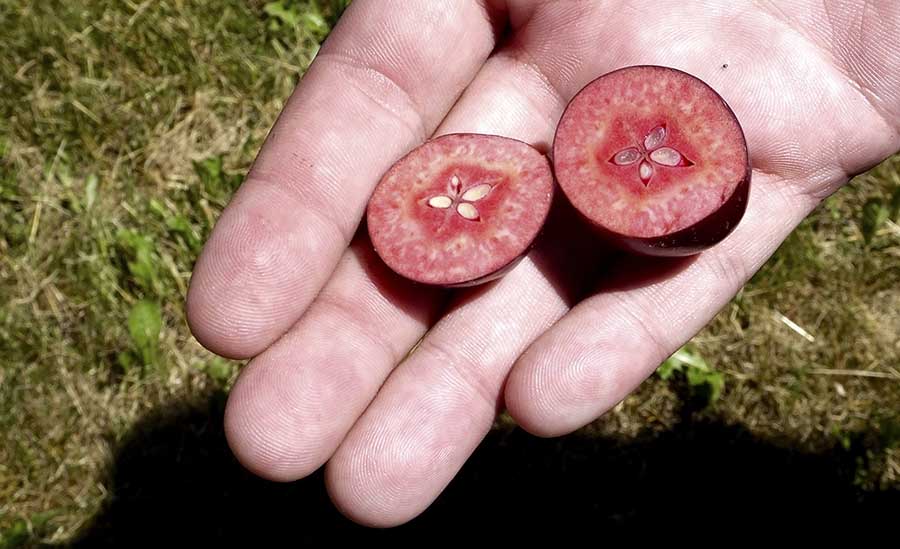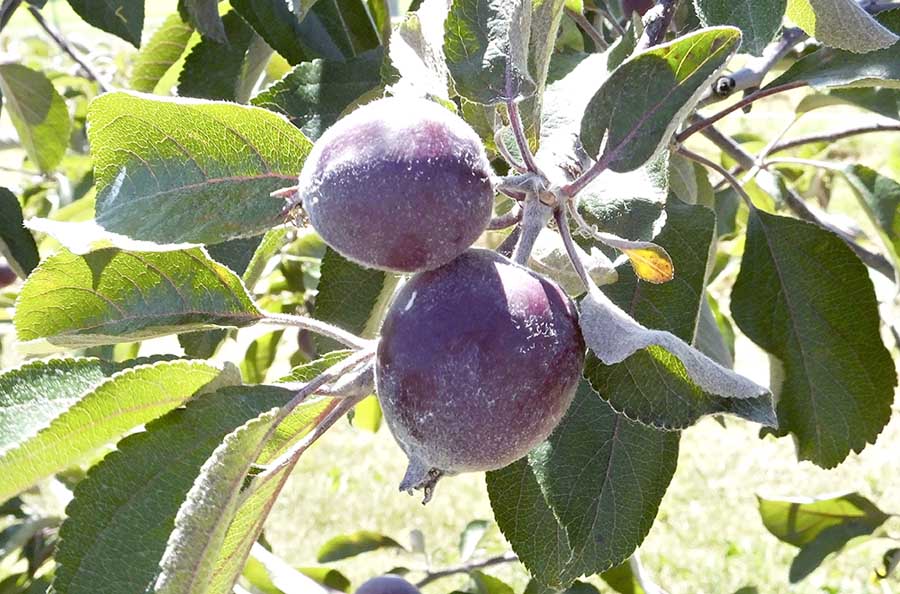
(By Leslie Mertz)” width=”900″ height=”549″> Even early in the year, Otterson’s flesh has rich, burgundy tones. Researchers from Michigan State University believe this quality could make the apple an excellent choice for natural red food color, nutraceuticals and ciders. (By Leslie Mertz)
Red is golden when it comes to the flesh of apples, according to Steve van Nocker, professor in Michigan State University’s Department of Horticulture.
He and his research group envision multiple uses for red-juiced apples, including natural red food coloring, antioxidant-filled nutraceuticals and unique hard ciders.
After about a decade spent examining hundreds of apple trees, van Nocker’s group settled on three of 15 top contenders that had what they wanted: cold-hardiness, disease resistance, vigor and a heavy concentration of anthocyanins that confer the crimson flesh color.
The finalists are natural variants with the names of Otterson, Cranberry and Irene.
Current interest in the three varieties comes mainly from cidermakers. The research group worked with two Michigan cideries over the last two years to produce rosé ciders.
One of the cideries, Short’s Brewing Company of Bellaire, Michigan, used Otterson to create an anniversary cider called Flamingo Juice for their Startcut brand line, said Chris Gottschalk, graduate research assistant in van Nocker’s group.
“They only released it from their pub for a few weeks, and it was a gorgeous dark-red color,” he said.
Gottschalk and van Nocker also tried some in-house brewing with the Cranberry variety and even entered it in the Great Lakes International Cider and Perry Competition (GLINTCAP) this past spring, Gottschalk said.
“Our cider won gold within the heritage category of the amateur brewers, which we think is a really promising result,” he said.
Van Nocker hopes to use the specialty-apple/hard-cider interest to propagate the varieties statewide. As supply increases, juice producers might become interested in creating a red juice from the apples.

(By Leslie Mertz” width=”900″ height=”594″> Shown here in late June, Otterson will grow to about the size of a baseball. Two cideries in Michigan used the red-juiced apple last fall to make a rosé hard cider. MSU researchers also brewed a batch of their own, entered it in the Great Lakes International Cider and Perry Competition and won a gold medal. (By Leslie Mertz
“There are actually very few sources of red color: beets, which is a different compound from anthocyanin and isn’t really used for food products; and anthocyanins derived from fruits such as cranberries, blueberries and acai,” he said. “What we’re talking about here would be a natural pure apple product.”
Since anthocyanins have antioxidant capacities, red-juiced apples could also be used to make nutraceuticals. “Certainly the anthocyanins could be extracted and made into supplements.
That’s a $100 million industry, and again, there’s not really a good source for that,” he said. His research group is currently working with Muraleedharan Nair, an MSU horticulture professor, to calculate the exact amount and types of antioxidants present within these apples.
Of the three top red-juiced apples, Otterson is producing the highest volume at MSU’s Clarksville Research Station in south-central Lower Michigan.
“Otterson is a very vigorous grower. We have about 40, 5-year-old, 12- to 14-foot-tall trees, and we got about an 18-bushel yield from them last fall, which is fairly good for a still juvenile tree,” Gottschalk said.
The apple has a somewhat mealy texture, so it is not a fresh-eating variety, but the size is excellent, he said. “I would say it’s probably about the size of my palm, so not quite as big as a Red Delicious, but a lot larger than normal crabapples,” he said.
Cranberry, on the other hand, can be eaten fresh.
“We got about four bushels last fall, but we only have about 15 of those trees,” he said. The oval-shaped apples are smaller than Otterson — about the size of a half-dollar — but they are very tasty, he said. “We haven’t hit full production yet on the Cranberry, so we don’t know the actual production per tree at their adult stage quite yet.”
Irene is a bit larger than Cranberry, has very rich red color, and has good vigor. Of the three, it is the most uncertain.
“We’ve seen varied results between two different years: One year was really good, and one year wasn’t,” Gottschalk said, noting that they will continue to watch the variety to determine whether to proceed with it.
The researchers planted more Irene, Cranberry and Otterson about two years ago and are observing the young trees for cold-hardiness and disease resistance.
They have also begun some thinning of the older trees to determine the effect on apple size and possibly juice characteristics.
In the coming six years of the project, which is funded by the Michigan Apple Commission, they will measure such fruit parameters as pH, titratable acids, Brix, phenolic content and color quantification.
“We think there’s a lot of viability with these red-juiced apples, and we’re hoping Michigan’s industry will start moving toward some specialty apple growing,” Gottschalk said. “The hard cider potential is interesting because it’s expanding exponentially. And given the interest in healthy natural products, these apples may be a unique product for that area to expand into.”
At least one fruit company outside of Michigan is taking an interest in red-juiced apples, too.
That is Stemilt Growers of Wenatchee, Washington. While the company doesn’t have juice commercially available yet, it does have a research and development project underway that “looks promising,” said Tate Mathison, Stemilt’s director of sales.
Beginning this winter, van Nocker hopes to offer growers a limited number of Irene, Cranberry and Otterson cuttings to graft.
Growers who are interested in cuttings may contact Chris Gottschalk at gottsc33@msu.edu or 248-860-2962. •
– by Leslie Mertz






Leave A Comment